Nicole C. Engard's Blog, page 7
March 19, 2015
Bookmarks for March 19, 2015
Today I found the following resources and bookmarked them on Delicious.
Calaos
Open Source Home Automation
Digest powered by RSS Digest
The post Bookmarks for March 19, 2015 appeared first on What I Learned Today....
Related posts:
Automation Survey
Open Education Spreading
Amazing OSS Podcast
March 18, 2015
Bookmarks for March 18, 2015
Today I found the following resources and bookmarked them on Delicious.
Meerkat
Tweet live video
23andMe
Genetic Testing for Ancestry
Find My Past
Trace your Family Tree Online – Genealogy & Ancestry
Digest powered by RSS Digest
The post Bookmarks for March 18, 2015 appeared first on What I Learned Today....
Related posts:
SxSW: We’re All Related. The (Big) Data Proves It
10 Ancestry.com Search Tips
Search all U.S. Censuses free
SxSW ImageThink Summaries
If you were looking at my Flickr stream from SxSW you probably saw some pretty neat image summaries of talks. These were done by ImageThink and are all on Slideshare:
I’d love to see more of this at the other conferences I attend!
The post SxSW ImageThink Summaries appeared first on What I Learned Today....
Related posts:
Library Camp Summaries
Library Camp Summaries
Summaries to come
March 17, 2015
SxSW: Moonshots and Reality
Dr. Astro Teller was our final keynote of the conference.
Astro created his second company in 1999 to take advantage of the future of wearables – BodyMedia. They designed a vest that would be used as an EKG. As an afterthought they brought people in to ask what they though of it – the interviews did not go well – and so we never saw this vest. The mistake they made was asking people what they though last instead of first. The longer you work on something the more you don’t really want to know what the world is going to tell you – you have to rush out there as fast as you can and as often as you can to get that info. In addition to getting this painful news from reality you have to find a way to use it.
The lesson failing at the beginning is what he has taken with him to Google X and the bumps and scrapes that it takes to improve is something we all share as life experiences. So today Astro is going to tell us what he’s learned and how he’s learned it at Google X.
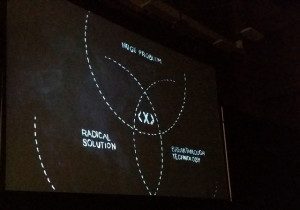 Moonshots mean that they are shooting for things that are 10x better – not incremental improvement. They are trying to produce items with real value – they embraced failure before deciding if they were going to take a moonshot. You have to make a ton of mistakes if you want to make great progress. All the bumps and scrapes have been well worth it. Some of the examples that he’s about to give us can be used to help us all with our experiments.
Moonshots mean that they are shooting for things that are 10x better – not incremental improvement. They are trying to produce items with real value – they embraced failure before deciding if they were going to take a moonshot. You have to make a ton of mistakes if you want to make great progress. All the bumps and scrapes have been well worth it. Some of the examples that he’s about to give us can be used to help us all with our experiments.
One of the projects out of Google X is Project Loon. “Project Loon looks to use a global network of high-altitude balloons to connect people in rural and remote areas who have no Internet access at all.” The problem in the beginning was that they didn’t want these balloons to fly in to a territory they weren’t allowed in. So what they did was design their first balloons to fail so that they didn’t have to deal with that issue. That allowed them to work on other areas of the project without having to worry about creating an international incident. Now they can fly their balloons 10-20 kilometers away to where they want it to go – up until then those they had to teach the balloons how to sale and how to destroy themselves so that if they went somewhere they weren’t supposed to go they could be destructed.
Another example is the self driving car. If you could build a car that was safer than humans it would solve so many problems. When they started they didn’t have the list of 10 thousand things they’d need to make this car actually work. Making that list though was the hardest part of this process and there was no other way to make this list then by going out there in to the world. One example was that their car came across a lady in a motorized wheelchair in the middle of the road with a broom trying to shoo a duck out of the street – the car needed to stop for this event and there was no way that the they would have envisioned that scenario if they hadn’t gone out there in the world.
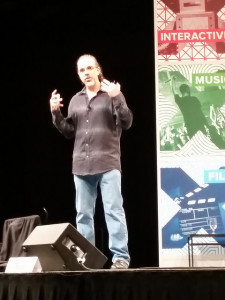 Google Glass is another example – they wanted to get the prototypes out quickly to a wide range of people so they could see how it was used and where it was used. They made one great decision and one not so great decision with Google Glass. The great one is that they got the glass out there. What they did not do well was that they got too much attention on the product – what they wanted to say was that this was an early prototype and was out there as a beta test. The problem is that the world saw it as a finished product when it was not that. They needed to prevent it from getting to be as loud a conversation as it got.
Google Glass is another example – they wanted to get the prototypes out quickly to a wide range of people so they could see how it was used and where it was used. They made one great decision and one not so great decision with Google Glass. The great one is that they got the glass out there. What they did not do well was that they got too much attention on the product – what they wanted to say was that this was an early prototype and was out there as a beta test. The problem is that the world saw it as a finished product when it was not that. They needed to prevent it from getting to be as loud a conversation as it got.
The key from these stories is that you have to prototype your tool – beta test it – you’re never going to get the right answer sitting in a conference room.
Project Wing is Google’s project for delivering things by self flying vehicles. They tried to find a vehicle that existed already that they could use, but they couldn’t find any out there. The decided they would build their own device. Even though 80% of the team knew it was the wrong answer after a year and a half they didn’t want to admit that. They wanted to get out in to the real world and test things. They were able to do 9 deliveries to Googlers and got proof that the device was wrong. This means that they were able to come back to the office and start designing a new vehicle.
Next a story of failing to fail … Project Makani. It’s an energy kite used to harness the wind. The higher up you are the more wind you have and the more power you get. The problem is that the towers you see are huge and you have to spend a ton to to build, move and put one of these up. The new kite tower weighs only 1% of the towers we’re used to seeing. So for the testing the team picked the windiest place possible – the speed and the direction of the wind can change in seconds. While they learned a ton – they did not fail – they never crashed one device like they thought they should. The team felt that they failed because they didn’t fail – there is magic in that.
Going back to the car … they thought they were ready in 2012 when their had Google employees using the cars. That car required human interaction to do things like exit and pay attention. They learned pretty quickly though that the only way was to have the car drive itself because the theory that humans can be a reliable backup for the system is a total fallacy. People do really stupid things when driving – they do really stupid things when driving for real – and when the they started to trust the system they really just let go of all reason.
All that said Astro doesn’t feel that he could have avoided the mistakes – he wishes that they had made the mistakes faster so that they could have learned faster. And he hopes that we can take away from his stories and set ourselves up for creative/productive failure.
The post SxSW: Moonshots and Reality appeared first on What I Learned Today....
Related posts:
SxSW: Fixing Transportation with Humanity & Technology
SxSW: Magical UX and the Internet of Things
Self Driving Cars
SxSW: Media, Tech and What’s Next
Pete Cashmere from Mashable was here to update us on tech.
Pete says that there is no excuse for media companies to not be involved in tech – enter Mashable Velocity. This is a tool in the Mashable app that predicts what’s trending in news.
While this technology is cool, it’s not going to replace the humans in news – we still need people to go out and get the new stories. We us AI learn about what’s going on on the web, it can learn patterns and it can learn from language – but it can’t write the story for you yet. Being successful on the web today requires that you’re “pro-human”. Human expression, creativity and human are all things that you can’t automate. Velocity can start the conversation, but it can’t tell the story.
Mashable wants to be your most faithful Facebook friend and your most trusted social network connection. They want to be your friend but they want to be trusted. Mashable wants to be accessible and approachable and still be reliable. Their target audience is the digital generation. The bulk of their audience is in the millennial group – but they see it as more of an attitude than an age group! I love that – I’m not a millennial but I do relate to a lot of the characteristics of a millennial.
Pete is a huge fan of Meerkat – live tweeting video (an article about Meerkat at SxSW). This is a new side of reporting. It’s important to not focus on making this perfect though – the beauty of it is that it feels human. Snapchat is another tool that Mashable uses a bunch. Facebook is joining the video realm and Mashable is using that tool too. They keep in mind that there are different ways to tell stories on each of these platforms and you have to keep that in mind.
We’re in an era of video – people want to see more video now and are producing more video. Mashable is going to head in this direction – produce more video. It’s way more obvious when you do video who you are – they want their videos to be fun and sharable. We’ll probably see in 3 to 5 years that most media companies are producing a majority of their content in video – it’s going to be a huge trend because it’s an easy medium to view on our mobile devices. (I’d argue that I don’t always have my headphones with me and so I don’t watch video when I’m mobile – I prefer to read).
When asked who the competition for Mashable was Pete said it depends on the platform. On Facebook they’re competing with your friend’s baby photos and on Twitter they’re competing with other news reporting outlets. Media has changed so much – you used to only consume media watching the news at night – but now you can be in line at the store reading news on your phone. People are consuming news in so many new places – and it’s all because of mobile. Mobile is making it so that media companies have to tell their stories more succinctly – writing/producing for the medium.
The post SxSW: Media, Tech and What’s Next appeared first on What I Learned Today....
Related posts:
Social Media Policies
SxSW: Behind the Social at WGBH
SxSW: End to Brogramming: How Women are Shaping Tech
SxSW: We’re All Related. The (Big) Data Proves It
AJ Jacobs, Joanna Mountain and Katarzyna Bryc were on the panel this morning titled “SxSW: We’re All Related. The (Big) Data Proves It” Joanna and Katarzyna are from 23andMe the makers of a DNA test for genetics. AJ is not a scientist like his fellow panelists but he is an author interested in research.
AJ got into this because he got an email one day saying “you don’t know me but I’m your 12th cousin”. He of course thought it was a hoax, but he looked in to it and found that this gentleman was actually part of a group who is creating the biggest family tree – right now there are 270 million people linked together on this tree. This got him in to genealogy and it’s a thrilling era for this type of research. One reason is DNA testing and the second reason is the Internet. I can confirm this – this is how I found most of my family between sites like Ancestry and Geni and FamilySearch and then social networks. With these sites it seems likely that in a few years we’ll have one giant tree connecting us to everyone on earth.
AJ found that he’s linked to Gwyneth Paltrow as his 16th cousin. Judge Judy is AJ’s 6th cousin 4 times removed. He’s even related to Barack Obama in some insane way that I couldn’t write down  and George Bush and Daniel Radcliffe and so many others.
and George Bush and Daniel Radcliffe and so many others.
23andMe is a service where you can send them your DNA and they will show you the breakdown of where you came from and list for you a list of hundreds of people who are related to you. They will also tell you what branch of the huge family you are on. Unfortunately AJ found that he is related to his wife – but in reality we’d all find the same thing.
We’re only 10 minutes in and I want to get one of these kits for everyone in my family and see what it turns up!!
AJ feels that we treat our family better than strangers and this research will show that we’re all related and will be bad news for bigots. AJ has decided to throw the biggest family reunion in history – it’s in New York on June 6th. There will be speakers, classes, and games for all the cousins. If you can’t attend in New York you can participate in branch parties or contribute to the IndieGoGo campaign.
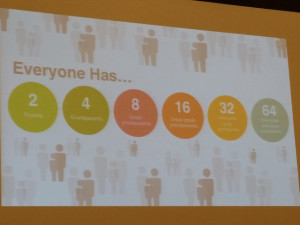 Joanna was up next to talk to us about what 23andMe does. Joanna showed us how DNA is the same in a family and explained how they use this technology to find out how much DNA we all share with each other. 850,000 people have been tested and your DNA is compared to all of those people. You can also allow 23andMe to share your info if you want with your cousins so that you can contact each other.
Joanna was up next to talk to us about what 23andMe does. Joanna showed us how DNA is the same in a family and explained how they use this technology to find out how much DNA we all share with each other. 850,000 people have been tested and your DNA is compared to all of those people. You can also allow 23andMe to share your info if you want with your cousins so that you can contact each other.
Other than learning that we have new cousins – what can we learn from all of this? Sometimes we don’t have our family stories due to a loss or a lie or a disease and Joanna shared stories with us of people were got connected to their families who had stories of their own to share.
 Katarzyna was up to talk to us about the numbers and the big data. She started with a lot of math! If every family had just 2 children you would have 1024 5th cousins. As you go back in time you have more and more cousins and maybe you do or don’t share DNA with. In 23andMe the typical customer has 2556 cousins.
Katarzyna was up to talk to us about the numbers and the big data. She started with a lot of math! If every family had just 2 children you would have 1024 5th cousins. As you go back in time you have more and more cousins and maybe you do or don’t share DNA with. In 23andMe the typical customer has 2556 cousins.
So, how much DNA do you need to share to be cousins? You have to have a certain segment of DNA in common to be cousins – but people who are cousins may not have the DNA to prove it. DNA is quite clear on who our first cousins are, but it’s harder as you get further out. The best way to do this is to get a bunch of your cousins tested.
I had a chance to ask the panel about data sharing. While I don’t want my DNA to be open sourced – I do want it shared across multiple genealogy DNA services. I pay for Ancestry.com for example to do research and I was going to use their DNA service, but it sounds like 23andMe has a better service that won’t be linked to my Ancestry account. The answer was that these services are all silos at this time and each offers a different service. Apparently people will submit their DNA to multiple services (which for me seems like it would get expensive). I’d love to see some service that shared information across services in a secure fashion.
After this talk I think I’m going to start a saving account just to get this info and I’m going to share this story with my family because I would love for us to share as much info as possible so that maybe I can connect to my family in Italy because as of now I’ve hit a wall in the paper only research method. Right now most of the customers for 23andMe are living in the US so I might hit a wall in genetic research as well.
The post SxSW: We’re All Related. The (Big) Data Proves It appeared first on What I Learned Today....
Related posts:
SxSW: New Social Networks Are Changing Entire Industries
SxSW: Building the Open Source Society
Library Related Conferences
March 16, 2015
Bookmarks for March 16, 2015
Today I found the following resources and bookmarked them
LINE
Free Calls & Messages
Digest powered by RSS Digest
The post Bookmarks for March 16, 2015 appeared first on What I Learned Today....
Related posts:
MarkMail: Mailing List Search
Open Source ILS Survey
Herding Cattle
SxSW: Fixing Transportation with Humanity & Technology
Today’s keynote was given by Logan Green, co-founder and CEO of Lyft. Logan spent most of his life growing up in LA surrounded by traffic. The idea for Lyft came to him while in Zimbabwe where community members often car pool to get places. Lyft is currently in 65 cities in the US.
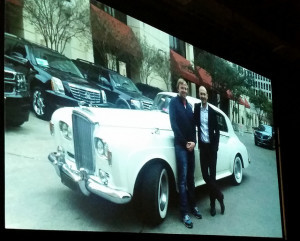 Lyft introduced Magic Mode for SxSW where you might get a ride in a fancy car. Most of the people in the room have tried Lyft (I have not … might have to give it a try next time I go to the airport). Logan started with the story of Lyft. LA (where he grew up) were built around automobiles – whereas older cities are built around people. He got tired of seeing cars around him with 4 empty seats – if people were sharing rides it would help with the traffic problem. He decided to perform an experiment and go without a car for a while and see what options he had.
Lyft introduced Magic Mode for SxSW where you might get a ride in a fancy car. Most of the people in the room have tried Lyft (I have not … might have to give it a try next time I go to the airport). Logan started with the story of Lyft. LA (where he grew up) were built around automobiles – whereas older cities are built around people. He got tired of seeing cars around him with 4 empty seats – if people were sharing rides it would help with the traffic problem. He decided to perform an experiment and go without a car for a while and see what options he had.
He was on a transportation board in Santa Barbara for 3 years and tried to fix public transportation – but he didn’t get anywhere. In Zimbabwe there is no public transportation – the government doesn’t provide it at least. The community built it’s own network. People would buy small buses and create route on their own. This city had a better system than Santa Barbara – a much more affluent city. This lead to the creation of Zimride – a web based ride-sharing service – you’d post your route and how many seats you had and what you wanted to charge per seat. The problem was that when people want transportation they want it now – this worked well for college kids looking for a ride home on weekends.
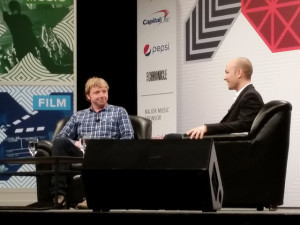 He wanted to make a transportation service that was so good you didn’t need to own a car – and Zimride wasn’t meeting that need. Soon after everyone started to carry around smart phones. This was the birth of Lyft. They decided to do background checks and put all these safeguards in place to make Lyft even safer than getting a taxi. Most importantly – where does the pink mustache come from? They come from Carstache another company that created them – Lyft originally ordered a few for fun for the office. They were looking for a way to show that they didn’t take themselves too seriously and they decided to hand them out to every driver. In the end the drivers actually started using them and were excited to use them. It turned out that the mustaches didn’t weather too well so they had to come up with a new option.
He wanted to make a transportation service that was so good you didn’t need to own a car – and Zimride wasn’t meeting that need. Soon after everyone started to carry around smart phones. This was the birth of Lyft. They decided to do background checks and put all these safeguards in place to make Lyft even safer than getting a taxi. Most importantly – where does the pink mustache come from? They come from Carstache another company that created them – Lyft originally ordered a few for fun for the office. They were looking for a way to show that they didn’t take themselves too seriously and they decided to hand them out to every driver. In the end the drivers actually started using them and were excited to use them. It turned out that the mustaches didn’t weather too well so they had to come up with a new option.
Uber has a different vision for the world. Uber is a car service. Lyft’s vision for the world is to make car ownership unnecessary. They are not trying to make a new taxi cab service. Over 2 trillion dollars are spent on transportation in the US and most of that is on our own personal cars – Lyft is trying to reduce the amount people have to spend on transportation. And of course offer you a better experience. To this goal Lyft introduced Lyft Line which is like a shuttle service but much more convenient.
From the business side of things where is the money going? Why do they have to raise so much money? Logan says it’s expensive to put up 4G towers around the country. For Lyft they want to have drivers be about 3 minutes away. So just like cell companies – Lyft is investing in their network. They are working on both driver and passenger acquisition.
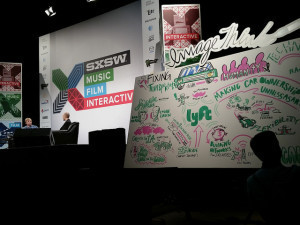 Right now there are hundreds of thousands of drivers on the road for Lyft – even Logan is a driver. There are people who do it 40-50 hours a week to those who are just on their way to work. Logan says that the nature of work is changing – flexibility is the new stability – people are looking for something different in their careers now. In LA 60% of their drivers work in the art industry – so they are using Lyft to fill the gaps in between pursuing their dreams. 30% of the drivers in San Fran are using Lyft to pitch their business to their riders. On the flip side some people feel that they are working a full time job but not getting the benefits of a full time employee. If people are so important to the business then why are drivers contractors instead of full time employees? The main reason is that Lyft needs people quickly and the people need jobs quickly – so the original idea wasn’t to cater to people who were doing this full time. The goal was to be flexible – if you want to ‘flip in to driver mode’ on your way to work you can.
Right now there are hundreds of thousands of drivers on the road for Lyft – even Logan is a driver. There are people who do it 40-50 hours a week to those who are just on their way to work. Logan says that the nature of work is changing – flexibility is the new stability – people are looking for something different in their careers now. In LA 60% of their drivers work in the art industry – so they are using Lyft to fill the gaps in between pursuing their dreams. 30% of the drivers in San Fran are using Lyft to pitch their business to their riders. On the flip side some people feel that they are working a full time job but not getting the benefits of a full time employee. If people are so important to the business then why are drivers contractors instead of full time employees? The main reason is that Lyft needs people quickly and the people need jobs quickly – so the original idea wasn’t to cater to people who were doing this full time. The goal was to be flexible – if you want to ‘flip in to driver mode’ on your way to work you can.
When asked about the allegations of poaching – Logan said that many people drive for both platforms and that’s encouraged and allowed by both Uber and Lyft. Neither platform was set up for exclusivity but Lyft does reward their most loyal drivers. Logan does agree that Uber has been unethical in this area and can’t speak more to it due to law suits.
Lyft is looking to grow internationally this coming year – they don’t have any cities to announce yet though. They aren’t looking to just ‘go’ international – they want to add value – they don’t want to be a taxi service they want to bring their ideals with them.
What role will self driving cars play in Lyft? Right now we’re looking at ‘partial’ self driving cars in the next few years. You still need a human in this case. Self driving cars only make a difference when you don’t need a human in the driver’s seat – and that product is a few more years down the road. When self driving cars come out it’s not just going to change Lyft – it’s going to change the entire transportation industry. In that case most people will probably choose to use a self driving car as a service instead of owning a car.
The post SxSW: Fixing Transportation with Humanity & Technology appeared first on What I Learned Today....
Related posts:
Self Driving Cars
SxSW: Magical UX and the Internet of Things
SxSW: Al Gore on Climate Change
SxSW: Storming the gates of the digital frontier
Another session that’s out of my wheelhouse this afternoon. A panel on breaking in to the film/TV industry by using the tools on the web today like YouTube. On this panel were : Derek Waters, Lauren Francesca, and Anthony Deptula all hosted by Todd Luoto.
Todd talked about the castle that is entertainment. There were people who decided who could come in to the castle – the gatekeeper. Then about 6 or 7 years ago there was a new castle – but it was an nice open beach house – that opened up called Vimeo and YouTube. This is the exciting time we’re living in – where there is a lot of money to be made with content creation without those gatekeepers in the way.
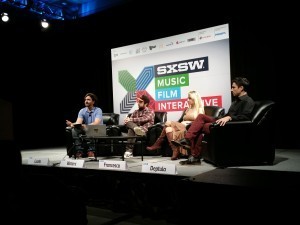 Derek started with how he got started in the industry. He always wanted to be an actor and started creating his own stuff because he got tired of auditioning for small parts in movies. In 2007 he started the Drunk History series. He had sent it around but nothing happened until he shared it on the Internet.
Derek started with how he got started in the industry. He always wanted to be an actor and started creating his own stuff because he got tired of auditioning for small parts in movies. In 2007 he started the Drunk History series. He had sent it around but nothing happened until he shared it on the Internet.
Lauren was up next to explain her start. She started by auditioning for a web series that became very popular and ended up on TV. It wasn’t really until she started doing her own stuff on YouTube that people really started recognizing her.
Anthony’s started in TV at the cable networks. He left that world to create content. He filmed a movie with some friends called ‘One Too Many Mornings” and it was going to be on YouTube rentals – it upset a lot of people that they had to pay for something on YouTube. Now he works at Maker Studios pulling data together to figure out how to combine the more traditional medium with the digital.
The new gatekeeper is the audience. Right now it seems like the audience is looking for ‘unboxing’ videos – they get 300-400 million views on these channels. Another trend right now is that a lot of people are on tablets viewing these videos – we might see that there aren’t Saturday morning cartoons anymore and instead kids are looking for their shows on their tablet on YouTube.
Lauren things that collaboration is key to have a successful video channel. You also have to think about what’s happening around you – doing sketches for specific holidays or something that’s trending on social networks. It means that you have to always be on board with doing something funny in conjunction with the news. Lauren says that her fans are her gatekeepers. She has to be careful to appeal to her audience which right now seems to be 12-35 year old boys – so they get upset if she does a video on unboxing a make-up product or something of that nature.
Derek was worried that moving to Comedy Central would make him lose what made him popular in the first place – but he was able to keep the content the same and have that control still even in the new space.
Todd asks if the speakers feel that YouTube is a training ground for traditional media – and Anthony replied by saying that it is not. People are doing amazing work – professional work on YouTube.
Lauren cautions that you need to leave a budget for marketing if you’re going to create a web series. There is so much content out there that if people have to filter through it all to find your stuff. Promoting your content is a full time job whereas the recording might take you a week. She suggests using YouTube as a way to break in to the industry because as Anthony said it’s a lot easier to send a link to an executive’s email address than it is to get them to watch your DVD. Short videos are the key. Derek encourages everyone to do their own stuff first.
Derek can’t remember the last DVD he bought – but he does know that almost everyone has a device they can watch media on. His transition from digital to being on Comedy Central. With the digital it was all about ‘no money’ – and he loved that. Now it’s hard to explain to a professional costume person that you want to wear converse sneakers in a historical sketch – but it’s great to have those professionals and those resources.
Lauren thinks that it’s foolish for an actor to not have a YouTube channel these days – but don’t just throw things out there – make them as good as possible – focus on your craft. Once it’s out there it’s always out there and the executives are looking.
The post SxSW: Storming the gates of the digital frontier appeared first on What I Learned Today....
Related posts:
NYLA: Leadership on the Digital Frontier
SxSW: Behind the Social at WGBH
SxSW: A New Generation: Creativity and Open Source
March 15, 2015
SxSW: A New Generation: Creativity and Open Source
For my final session of the day I attended an interview of Ryan Leslie by Matt Mullenweg titled “A new generation: Creativity and Open Source”.
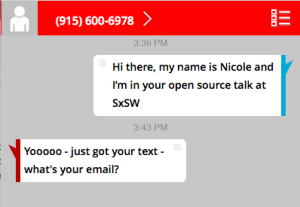 Ryan Leslie graduated from Harvard at 19 and on the forefront of technology and music. Ryan gave us all his cell phone number so we could text him during the session because he’s very in to being open and giving back. “As creators we try to find our way in the dark – we don’t have any concrete data on who’s buying our music”. When his second album was released he wondered by the label couldn’t just email everyone who bought his first album to tell them about his album. The problem is that the labels don’t have that info. So Ryan shares his info with his fans so that he can keep in touch with them. He used the Twilio API to create a tool to reply to text messages he gets asking the sender for their email address.
Ryan Leslie graduated from Harvard at 19 and on the forefront of technology and music. Ryan gave us all his cell phone number so we could text him during the session because he’s very in to being open and giving back. “As creators we try to find our way in the dark – we don’t have any concrete data on who’s buying our music”. When his second album was released he wondered by the label couldn’t just email everyone who bought his first album to tell them about his album. The problem is that the labels don’t have that info. So Ryan shares his info with his fans so that he can keep in touch with them. He used the Twilio API to create a tool to reply to text messages he gets asking the sender for their email address.
Ryan decided that he was going to sell records on his own instead of through a label and has made significantly more money that way. When working with the label it’s like the worst business loan that ever. Instead you can use tools like Tilt, Kickstarter and other crowdfunding sites to get that loan to start up the business and publish your own records. When you’re able to connect directly with your users you can identify who your real supports are.
Instead of spending money on a tool like salesforce Ryan decided to spend 40 days on CodeAcademy and learned Ruby on Rails and wrote his own tool using Twilio to now gather info on his audience. Before he would just get sales reports from iTunes – once he started selling direct he got a better feel for who it was who was listening to him music. “Everyone you know, whether they buy your album or not, can contribute to your project” – contacts as currency. “It’s beautiful when the communication can be two way”.
Ryan shared a story where he and several other musicians were all together and started coming up with a song together and collaborating on the sound. Matt said this was the story that was the most like open source – where several artists come together to collaborate and build something special together.
Ryan made a very open source comment – some of the most successful solutions are when they solve for a problem they face personally. He wants software that was developed by people like him. He mentioned TopSpin which never really worked for him because he didn’t know who wrote it – or where they came from (life experiences). It comes down to shared experiences – even moving up in the music industry is about the people they know and their relationship equity.
Matt recommended that we all read 1,000 True Fans by Kevin Kelly.
“When creators are inspired they share it” – Ryan Leslie
The post SxSW: A New Generation: Creativity and Open Source appeared first on What I Learned Today....
Related posts:
SxSW: Building the Open Source Society
ATO2014: Open Source Schools: More Soup, Less Nuts
The open source behind Twitter



